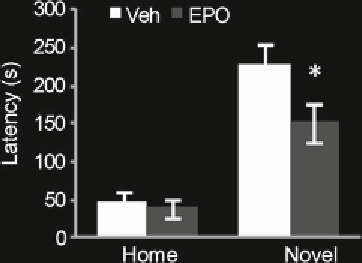Biology Reference
In-Depth Information
Fig. 2
Consumption latency in the novelty-induced hypophagia test is decreased in mice that received 4 days
of EPO treatment (500 U/kg, i.p.). Testing was performed 4 h after the last EPO treatment. *
p
= 0.05. Students
t
test,
n
= 7-8
9. The procedure is repeated for remaining pairs of mice.
10. Latencies to drink in the homecage and the novel cage are the
reported measures (see Fig.
2
).
3.4 Novel Object
Recognition in Mouse
CEPO (30
g/kg) is injected intraperitoneally (i.p.) to a group of
mice and vehicle is similarly administered to a second group of
mice (8/group). This occurs on 2 consecutive days.
μ
3.4.1
Habituation (Day 1)
1. CEPO and vehicle are administered as on the prior day to the
same groups of mice. This is the 3rd consecutive day of treat-
ment. Habituation occurs 4 h after treatments.
2. All mice to be tested are brought in their homecages into a
quiet holding room near the testing room. Mice are placed
into individual clean mouse cages with fresh bedding, in the
experimental room which is dimly lit. Tops are placed on each
cage and mice remain in these cages undisturbed for 1 h.
3. Return mice to homecages and normal housing room (see
Notes 3, 4, 6).
3.4.2
Acquisition (Day 2)
1. CEPO and vehicle are administered as on the prior days to the
same groups of mice. This is the fourth consecutive day of
treatment. Time injections so that mice are given their object
exposure sessions 4 h post-treatment.
2. All mice to be tested are brought in their homecages into a
quiet holding room near the testing room. In the testing room,
a clean cage with fresh bedding is set on the observation table
and the cleaned objects are placed at opposite ends of the cage.
The camera is set up to record the behavior during the session.
The room is kept in dim lighting (see Note 7).
3. A mouse is brought to the experimental room and placed in
the middle of the test cage, the top is closed and the experi-
ment timer is started.

Search WWH ::

Custom Search